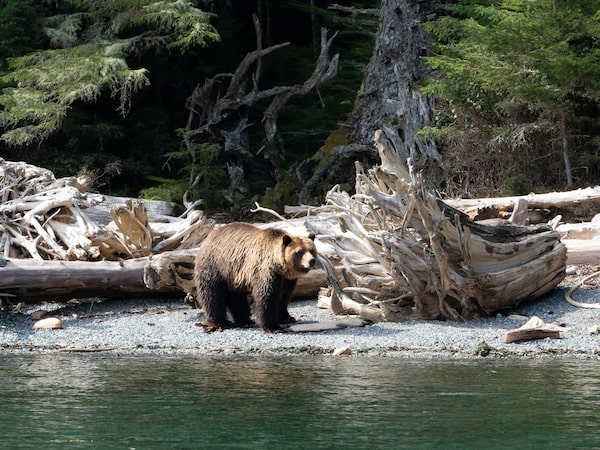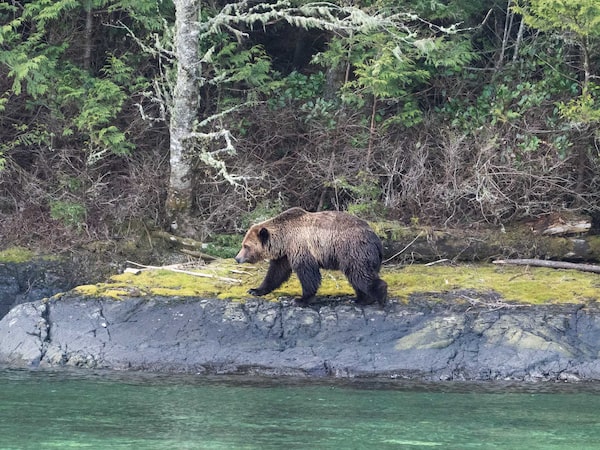
An undated photo of a young grizzly bear relocated from Hanson Island to Broughton Archipelago.Courtesy of manufacturer
When Mali woke late last month from his long, winter’s nap, he did what all sleepy, young grizzlies do after exiting their snowy dens: He set off immediately to find something to eat.
So began an incredible journey that took the bruin all the way from B.C.’s central mainland to the coast of Vancouver Island, and back again. Although it would earn the big, brawny bear a place in the province’s history, it ended in a way that few who got to know him saw coming.
Provincial officials believe that what officers chose to do with the bear could provide a blueprint for a new, Indigenous-led approach to grizzly-bear management in the province. In 2017, Victoria summarily ended the grizzly-bear trophy hunt, sparing 300 animals a year. Mali could end the shooting of these bears altogether in B.C.
Mali came ashore from his monster swim on Hanson Island in the Broughton Archipelago, a maze of islands just off the northern flank of Vancouver Island. The Broughton’s cedar forests are rich with Indigenous history. Its narrow passages are alive with killer whales, seals, porpoises and eagles.
The Broughton Archipelago Marine Park draws wildlife tourists from around the world. With the decline of logging and the fishery, ecotourism is playing an increasingly large role in the local economy. Bear viewing, kayak tripping and sport fishing are some of the biggest draws.
Grizzlies are not native to the Broughton. But declining salmon runs along the central coast have sent them searching for food far beyond their normal range. There are enough mussels, huckleberries, skunk cabbage and sedge grass in the region’s muddy estuaries to keep a bear happy until the salmon start to run in late summer.
Scientists estimate that Mali was three, and in his first year outside his mama’s den. Older, more dominant bears, some perhaps jealously guarding their feeding sources, may have chased him off their ranges.
Grizzlies have a sense of smell 100 times that of humans. Mali’s keen nose unfortunately led him to a pile of garbage that a cottage owner had improperly stored.
Not long ago, this would have triggered an automatic death sentence for a bear in B.C.: Conservation officers consider bears who have gotten into trash to be “habituated” and destroy them, says Nicholas Scapillati, head of the Grizzly Bear Foundation. Officers have put down 162 grizzlies and more than 4,000 black bears in the past eight years in B.C.
But Mali happened to swim onto the traditional territory of the Mamalilikulla First Nation. Richard Sumner, chief of the Kwakwa̱ka̱ʼwakw community, refused to allow conservation officers to fire a shot.
The Mamalilikulla revere the grizzly for its ferocious strength. Their oral history says some of their ancestors are descended from the animal. Grizzlies run through many of their songs, stories and art.
Some of the region’s residents, however, are terrified by the growing number of grizzles being drawn to the area.
The plan to spare Mali arose from the killing of a grizzly named Gatu by a resident in the coastal village of Kingcome in November of last year. Gatu’s death sparked anger and grief in some First Nations communities and among local tour operators, according to Mike Willie.
The 42-year-old hereditary chief of the Kwikwasut’inuxw Nation grew up in Kingcome but was forced to leave, at the age of 12, for high school in Victoria. His bear-viewing outfit, Sea Wolf Adventures, grew from his yearning to return to the ocean, and to his culture.
Following Gatu’s death, Mr. Willie teamed up with the Grizzly Bear Foundation and two powerful First Nations leaders, Mr. Sumner and Douglas Neasloss, former chief of the Kitasoo/Xai’ xais Nation.
In March, they met with B.C. Environment Minister George Heyman and lobbied for the modernization of a provincial wildlife act written in the 1800s, with few updates and zero First Nations input.
Science has its place, Mr. Willie told the minister. “So do the cultural values that have formed and shaped our interaction with these territories for 14,000 years. That also needs a place at the table.”
Half of Canada’s grizzlies live in B.C. – some 15,000, according to provincial modelling. “Together, we mapped out a different approach,” prioritizing “co-existence” with the bears, Mr. Willie says.
Just a few days later, Mali swam ashore. Conservation officers ordered the bear destroyed. That is “not an option,” Mr. Sumner told them. “This is our territory.”
Inspector Ben York, the conservation officer in charge of B.C.’s West Coast, was called in. So was Mr. Heyman, who encouraged a non-lethal approach, according to people briefed on the call.
Mr. Willie, who was sidelined by the pandemic in Victoria, paced his small home, cellphone in hand. “If you want reconciliation, this is exactly what we’re talking about,” he told officers.
Hour after hour, the two sides went back and forth until Mr. York finally broke: “Okay, chief,” he said, addressing Mr. Sumner. “We’ll try your way.”
It took two days for officers, working with two Indigenous guardians, to trap the wily bear. They gently laid the tranquilized bear on a mat, applying ointment to keep his eyes moist, dousing him with sea water to keep him cool and blindfolding him to keep him calm.
On April 13, a government helicopter airlifted the bear to an inlet in the Great Bear Rainforest. We saved a grizzly, Mr. Willie remembers thinking. “It felt so good.”
When Mali woke, he “wasn’t eating garbage,” Mr. Scapillati said. He immediately began stumbling around, feeding on sedge grass and mussels in a remote estuary – "what he should have been doing all along.”
“Our officers, our senior bureaucrats – all of us are learning to listen,” Mr. Heyman said in a statement released to media. “We are learning to make space for conservation.”

The hereditary chief of the Kwikwasut’inuxw Nation – teamed up with the Grizzly Bear Foundation and two powerful First Nations leaders – met with B.C. Environment Minister George Heyman and lobbied for the modernization of a provincial wildlife act written in the 1800s.Suzie Hall/Supplied
The fates, however, had decided against a happily-ever-after ending to this story.
Ten days after Mali’s release, Mr. Heyman telephoned Mr. Willie: The bear had been shot to death, just 30 kilometres from where he was released, he said. Mali had swum to a tiny island, where he came upon a resident and his barking dog.
The citizen told conservation officers that he shot the bear twice in self-defence. Dogs are known to agitate grizzlies and can trigger attacks, which may have occurred in this case.
“It is fortunate the resident is safe,” Mr. Scapillati said. “But this could have been avoided. Bear spray has been proven to be more effective than guns.”
To honour the bear, the region’s three first nations are planning a series of travelling town halls focusing on the use of bear spray and rubber bullets, and on bear-proofing trash, gardens, fruit trees and barbecues. He won’t be the last grizzly to turn up in the Broughton.
The minister assured Mr. Willie, who broke down after hanging up, that Mali will provide the outline for a “new, collaborative” wildlife management process going forward.
The grizzly’s remains will be returned to the Mamalilikulla First Nation. Following a ceremony, he will be buried on their traditional territories.
“We failed Mali,” Mr. Willie says. All the joy and energy in his voice had gone. “This is really hard to swallow.”
Our Morning Update and Evening Update newsletters are written by Globe editors, giving you a concise summary of the day’s most important headlines. Sign up today.